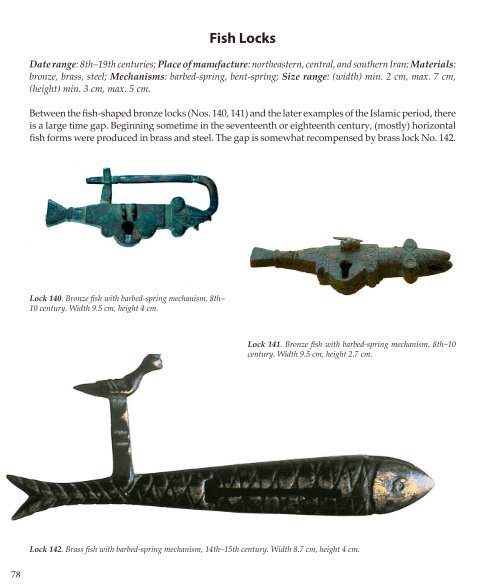Persian Locks: 1500 Years of Iranian Padlocks
In Iran, the padlock was developed in an amazing variety of sizes, shapes, materials, and mechanisms, the likes of which are less frequently encountered in Europe. On the whole, very little attention has been devoted to the history and development of the lock in Iran. Parviz Tanavoli, Iran's leading sculptor, was first attracted to the locks of his own country because of their sculptural qualities. In this beautiful and informative book the author shares with us, in over 500 photos and drawings, the most interesting examples of locks from his famous collection which was first introduced to the American public by the Smithsonian Institute on the occasion of the American Bicentennial. You will also find detailed drawings which clearly illustrate the workings of the various locking mechanisms (e.g., barbed-spring, helical-spring, notched-shackle, hook and revolving catch, etc.) used in the locks in this book. All locks are dated and when known, the place of manufacture is given. A smaller version of this updated and expanded book was published by The Smithsonian Institution in 1976 with the title, "Locks from Iran: Pre-Islamic to Twentieth Century." In 2019 and 2020 the author edited his original book adding new text and a great number of new high-quality photos of locks which have been added to his collection in the 44 years since the first book was published. Hardcover, 144 pages, 10-inches x 8.5-inches, over 500 photos and drawings.
In Iran, the padlock was developed in an amazing variety of sizes, shapes, materials, and mechanisms, the likes of which are less frequently encountered in Europe. On the whole, very little attention has been devoted to the history and development of the lock in Iran.
Parviz Tanavoli, Iran's leading sculptor, was first attracted to the locks of his own country because of their sculptural qualities. In this beautiful and informative book the author shares with us, in over 500 photos and drawings, the most interesting examples of locks from his famous collection which was first introduced to the American public by the Smithsonian Institute on the occasion of the American Bicentennial. You will also find detailed drawings which clearly illustrate the workings of the various locking mechanisms (e.g., barbed-spring, helical-spring, notched-shackle, hook and revolving catch, etc.) used in the locks in this book. All locks are dated and when known, the place of manufacture is given.
A smaller version of this updated and expanded book was published by The Smithsonian Institution in 1976 with the title, "Locks from Iran: Pre-Islamic to Twentieth Century." In 2019 and 2020 the author edited his original book adding new text and a great number of new high-quality photos of locks which have been added to his collection in the 44 years since the first book was published.
Hardcover, 144 pages, 10-inches x 8.5-inches, over 500 photos and drawings.
You also want an ePaper? Increase the reach of your titles
YUMPU automatically turns print PDFs into web optimized ePapers that Google loves.
Fish <strong>Locks</strong><br />
Date range: 8th–19th centuries; Place <strong>of</strong> manufacture: northeastern, central, and southern Iran; Materials:<br />
bronze, brass, steel; Mechanisms: barbed-spring, bent-spring; Size range: (width) min. 2 cm, max. 7 cm,<br />
(height) min. 3 cm, max. 5 cm.<br />
Between the fish-shaped bronze locks (Nos. 140, 141) and the later examples <strong>of</strong> the Islamic period, there<br />
is a large time gap. Beginning sometime in the seventeenth or eighteenth century, (mostly) horizontal<br />
fish forms were produced in brass and steel. The gap is somewhat recompensed by brass lock No. 142.<br />
Lock 140. Bronze fish with barbed-spring mechanism, 8th–<br />
10 century. Width 9.5 cm, height 4 cm.<br />
Lock 141. Bronze fish with barbed-spring mechanism, 8th–10<br />
century. Width 9.5 cm, height 2.7 cm.<br />
Lock 142. Brass fish with barbed-spring mechanism, 14th–15th century. Width 8.7 cm, height 4 cm.<br />
78










